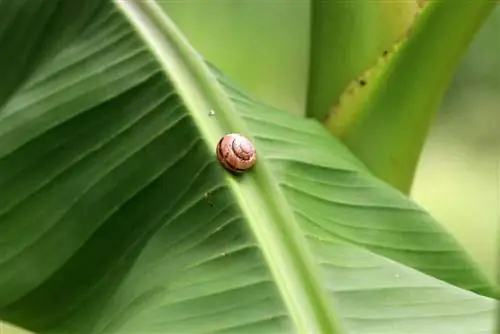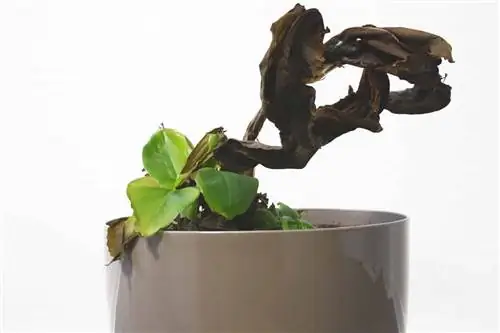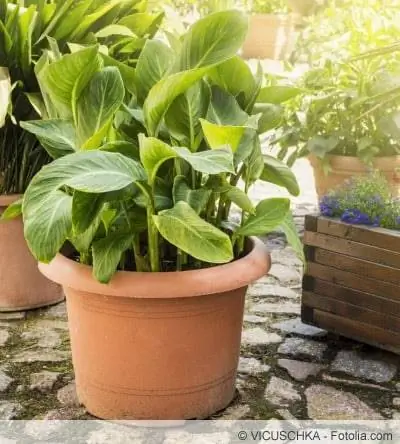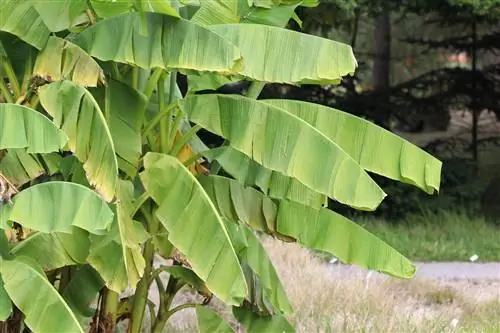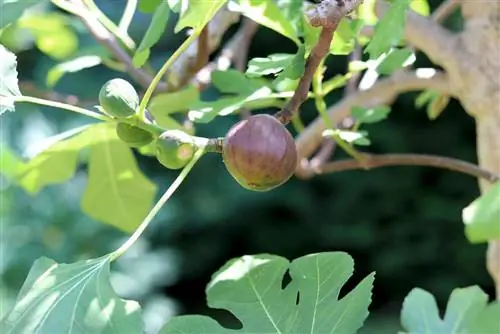- Author admin [email protected].
- Public 2023-12-17 03:39.
- Last modified 2025-06-01 06:48.
With ornamental bananas, the floral magic of the tropics finds its way into living rooms, offices and on the summer balcony. The impressive Musa Banana has distinguished itself as a premium species because it combines exotic opulence with frugal demands. This care guide highlights all the details surrounding successful cultivation in the pot. A well-founded guide to wintering leaves no questions unanswered as to how you can guide the picturesque plant beauty unscathed through the cold season.
Location
Monumental, evergreen leaves up to 2 meters long are the most beautiful decoration of ornamental bananas. Blazing sunshine causes significant leaf damage after a short time due to burns, because Musa bananas come from the twilight of tropical rainforests. Another criterion for the perfect choice of location is the pronounced sensitivity to cold with a minimum temperature of 10 degrees Celsius, which can briefly drop to 5 degrees Celsius. Correct placement behind glass and in the open air therefore plays a key role in care. The best options are summarized in the following overview:
- All year round in a bright to partially shaded location in living rooms, offices or temperate winter gardens
- Ideally with increased humidity of more than 60 percent
- No cold drafts caused by tilted windows or opened doors
- Optimal temperature level between 18 and 28 degrees Celsius
- From the beginning of June to the beginning of September on the balcony or terrace
- Preferably sheltered from the wind outdoors
A popular location option is to plant ornamental bananas in a bright, not full-sunny garden bed during the warm season. You can either plant Musa Banana from June to September in normal, fresh garden soil or place the plant and its container in the ground. The latter variant makes it easier to put away in the fall, especially if the pot is equipped with two handles. An ornamental banana is suitable for a summer outdoor space from the second year onwards when it has reached a minimum height of 100 centimeters.
Substrate quality
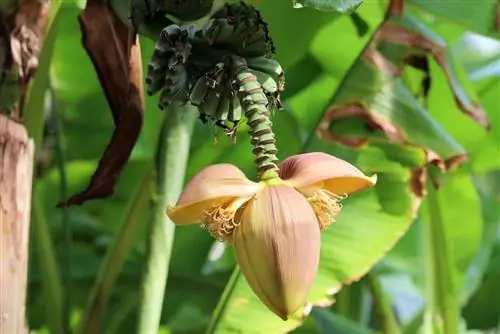
The ornamental banana wants a loose, permeable substrate with a proportion of inorganic additives, such as lava granules or expanded clay. We recommend a peat-free potting soil. Potting soil containing peat has fallen into twilight not only because of ecological concerns. The low rewettability and tendency to compaction as well as the minimal nutrient requirement mean that knowledgeable home gardeners turn to alternatives. High-quality pot substrates use peat substitutes, such as coconut or wood fibers, as additives, which benefit the growth and vitality of your Musa Banana.
The perfect bucket
A bucket with a diameter of 40 to 50 cm, or a capacity of 3 liters, offers a young ornamental banana enough volume for growth. Since the plant develops into a heavyweight, we recommend a container with integrated wheels. It is important to have an opening in the floor for water drainage so that harmful waterlogging cannot form. The size of the container increases in proportion to growth. Every time you repot, check whether there is 2 finger-widths of space between the root ball and the edge of the pot. The distance shouldn't be any larger so that the tropical plant doesn't grow over your head.
Skillfully potting and repotting - this is how it works
Give the floral ambassador of the tropics a warm welcome by repotting the Musa Banana immediately after purchasing it. In this way, you avoid imponderables such as poor-quality substrate or a pot that is too small. How to do it right:
- Lay out some pottery shards on the floor of the new bucket as drainage
- Optionally place an air- and water-permeable fleece over it to protect against siltation
- Fill in the recommended substrate up to half the height of the pot
- Unpot the ornamental banana and plant it in the middle of the new pot
- Keep previous planting depth unchanged
A watering edge of 2 to 3 centimeters simplifies the water supply. Press the substrate with your hands to prevent air pockets. In the last step, water the decorative banana until the water runs out of the bottom opening.
Use this method to repot your Musa Banana every spring into fresh substrate and, if necessary, larger pots. The best time for this important care measure is at the end of the winter break, shortly before this year's growth begins.
Tip:
Please do not confuse a frost-sensitive Musa banana with its winter-hardy counterparts, such as Musa basjoo or Musa acuminata. Since all types of bananas rarely bloom and fruit in the Central European climate, they are all referred to as ornamental bananas in specialist retailers. Therefore, please ask specifically for the botanical species name when purchasing.
Water supply and humidity - tips & tricks
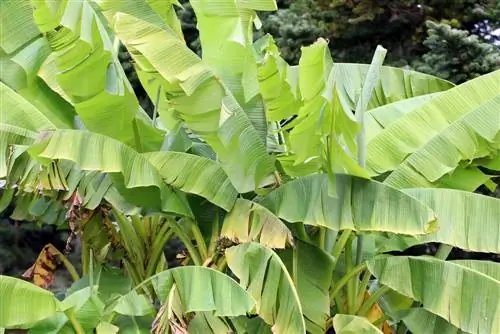
Your Musa Banana is very comfortable with a combination of slightly moist soil and high humidity. In order to perfectly cover the moisture requirements of the substrate and leaves, please use collected rainwater or decalcified tap water. The high degree of evaporation via the huge decorative leaves requires the use of the watering can twice a day on hot summer days. Of course, you shouldn't water without a finger test beforehand, as stagnant moisture causes the fleshy roots to rot within a short time. How to water and moisten an ornamental banana with gardening expertise:
- During the warm season, press a finger 2 cm deep into the substrate every day
- If the soil is noticeably dry, water with soft water
- Pour out the coaster after 15 minutes at the latest
- Spray the leaves regularly with lime-free water
Annoying pouring of the coaster is no longer necessary if you fill in pebbles or grit. This precaution also has the advantage that evaporating water increases the local humidity. If the ornamental banana is in a room or winter garden, commercially available humidifiers regulate the humidity automatically. If you don't have a rain barrel, let the irrigation water stand for a few days to reduce the lime content. To turn very hard tap water into soft watering water for Musa Banana, hang a cloth bag with 1 liter of peat in a 10 liter container for 3 days.
Fertilize in a balanced way - this is how you do it right
The nutrient requirements of ornamental bananas are high. A continuous supply of plant food is required for the growth of the herbaceous pseudo-stem, powerful leaves and large flowers. The nutrient reserves in fresh soil are used up within 3 to 4 weeks. Regular fertilization is therefore an important asset in the Musa Banana care program. This is how it works:
- Add a liquid fertilizer to the irrigation water every week from April to September
- From October to March, fertilize liquidly at half concentration at 4-week intervals
Alternatively, administer an organic complete fertilizer in stick or granule form according to the manufacturer's instructions. Before and after each fertilization, please water with clear, soft water.
Cut ornamental banana
Pruning is not necessarily part of the care of Musa Banana. The evergreen tropical plants develop their impressive shape without pruning. From time to time the older leaves dry out on the outer edge, which makes it useful to use a knife or scissors. The same applies if the banana plant exceeds the spatial dimensions and should be reduced in size. How to cut an ornamental banana correctly:
- Pull the dead banana leaf down to the root collar
- Separate with a firm tug or cut with a sharp knife
- For a radical cut, cut the pseudo stem horizontally halfway up
- Caution: radical cutting will significantly set back the growth of the ornamental banana
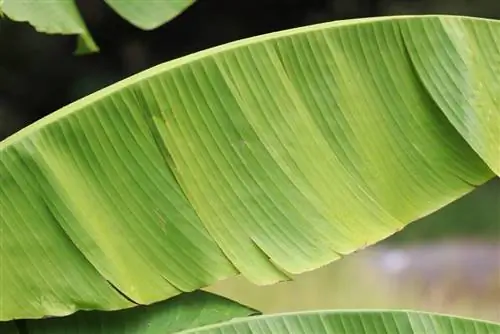
To limit further growth, combine pruning with root pruning. To do this, pot up the ornamental banana and remove the substrate with a bonsai hook. First, cut off all diseased, stunted and dead roots. Then shorten root strands that are too long by one third to two thirds so that a homogeneous root ball is created. Last but not least, pot the reduced ball in fresh substrate according to the instructions above and water.
Tip:
If the ornamental banana is in the living room and office, it makes a valuable contribution to well-being. Scientists discovered that Musa Banana and other ornamental banana species filter the air we breathe with their huge leaves. At the same time, the exotic green plants increase the humidity to an ideal level to prevent and relieve tired eyes or respiratory irritation.
Propagation - this method works
As it gets older, the ornamental banana forms numerous buds to ensure its continued existence. The plant also takes this precaution after its only flowering period. Musa Banana bear decorative flowers once and then gradually die off. In order to use the daughter plants for propagation, they should be connected to the mother plant for as long as possible. Only when a child has its own roots is it prepared for an independent life. Here's how to proceed expertly step by step:
- Best time is in spring during repotting
- Peel off the child or cut it off with a sharp knife
- Plant in a pot with coconut fiber substrate and water
- Place the pot under a transparent hood or put a plastic bag over it
In the partially shaded, warm window seat, please ventilate the cover every day. Take this opportunity to use a finger test to check whether the substrate needs to be watered. Thanks to the warm, humid microclimate under the hood, rooting progresses quickly. If the first fresh leaf tips signal success, you can remove the cover. What you do with the mother plant is your horticultural decision. If the plant is still largely green and alive, there is a good chance that it will sprout more children in fresh substrate.
Instructions for wintering
In October the ornamental banana slowly stops growing and takes a winter break from November to March. In order for the plant to keep its evergreen foliage without interruption, it is important to overwinter properly. The focus is on a combination of pleasant room temperatures, bright lighting conditions, high humidity and a reserved supply of water and nutrients. How to overwinter Musa Banana properly:
- In a bright to sunny location at temperatures of 15 to 20 degrees Celsius
- Optimize semi-shaded to shady lighting conditions with daylight lamps
- Alternatively, under low-light conditions, lower the temperature to 10 to 12 degrees Celsius
- Watering more sparingly so that the soil doesn't dry out
- Spray several times a week with room temperature water
- In winter, fertilize liquid once a month
If your ornamental banana lingers on the balcony or planted out in the bed in summer, please put the plant away in good time. Place a minimum-maximum thermometer nearby. If the device shows in the morning that the nighttime temperature has fallen below 10 degrees Celsius, the plant moves to its winter quarters. Dig up the planted Musa Banana and pot the root ball in a pot with coconut fiber substrate.
Diseases, pests and other problems
Brown leaf edges and penetrant spider mites are the two most common problems with ornamental bananas. Neglects in care cause these difficulties. Too low humidity or drought stress causes the edges of the leaves to brown. Conditions that are too dry also provide an ideal target for spider mites. If you have discovered the pests on and under the leaves, shower the pests off. Alternatively, wipe the insects off with an alcohol-soaked cloth. From now on, use the measures recommended in these care instructions to increase the air humidity to prevent brown leaf edges and a new spider mite invasion.

